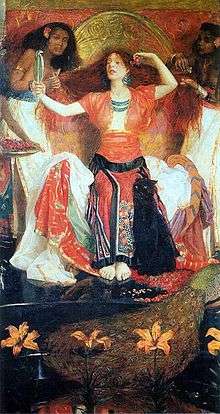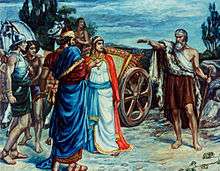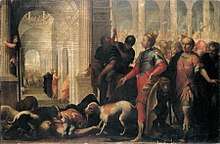Jezebel
Jezebel (/ˈdʒɛzəbəl, -bɛl/, Hebrew: אִיזֶבֶל)[1][2][3] was the daughter of Ithobaal I of Tyre and the wife of Ahab, King of Israel, according to the Book of Kings of the Hebrew Bible (1 Kings 16:31).[4]
Jezebel Queen of Israel | |
|---|---|
 19th-century painting by John Liston Byam Shaw | |
| Personal | |
| Died | c. 842 BC |
| Religion | Baalism |
| Spouse | King Ahab |
| Children | Ahaziah, Jehoram, and Athaliah |
| Parents | Ithobaal I |
According to the Biblical narrative, Jezebel, along with her husband, instituted the worship of Baal and Asherah on a national scale. In addition, she violently purged the prophets of Yahweh from Israel, damaging the reputation of the Omride dynasty.[5][6][7][8] For these offences, the Omride Dynasty was annihilated, with Jezebel herself suffering the gruesome death of defenestration.
In later Christian tradition, Jezebel was associated with false prophets.[9]
Meaning of name
Jezebel is the Anglicized transliteration of the Hebrew אִיזָבֶל ’Îzeḇel. The Oxford Guide to People & Places of the Bible states that the name is "best understood as meaning 'Where is the Prince?'" (אֵיזוֹ בַּעַל ’ēyzō ba’al), a ritual cry from worship ceremonies in honor of Baal during periods of the year when the god was considered to be in the underworld.[10]
In Hebrew, the unvocalized spelling of Jezebel is the same as that of the etymologically distinct name Isabelle, a French form of the Hebrew name Elisheva.
Biblical account

She is introduced into the Biblical narrative as a Phoenician princess, the daughter of Ithobaal I, king of Tyre (1 Kings 16:31 says she was "Sidonian", which is a biblical term for Phoenicians in general).[10] According to genealogies given in Josephus and other classical sources, she was the great aunt of Dido, Queen of Carthage.[10] As the daughter of Ithobaal I, she was also the sister of Baal-Eser II. Jezebel eventually married King Ahab of Samaria, the northern kingdom of Israel.
The wedding ceremony of Ahab and Jezebel is recorded, according to Near Eastern scholar Charles R. Krahmalkov, in Psalm 45.[11] This marriage was the culmination of the friendly relations existing between Israel and Phoenicia during Omri's reign, and possibly cemented important political designs of Ahab. Jezebel, like the foreign wives of Solomon, required facilities for carrying on her form of worship, so Ahab made a Baalist altar in the house of Baal, which he had built in Samaria.[12] Geoffrey Bromiley points out that it was Phoenician practice to install a royal woman as a priestess of Astarte, so thus she would have a more active role in temple and palace relations than was customary in the Hebrew monarchy.[13]
Elijah

Upon coronation as queen, the official royal support for Yahwism had weakened. Temples and altars dedicated to Baal were built, elevating Baal to a national status.[14] Jezebel additionally used royal provisions to fund the 450 prophets of Baal and the 400 prophets of Asherah, during a severe famine in Samaria.[15] Meanwhile, Yahwism was systematically purged. Altars dedicated to Yahweh were torn down and desecrated. Many prophets of Yahweh were killed, leaving only 100 survivors.[16] Obadiah, a pro-Yahwist figure in Ahab's royal court, secretly protected these survivors in a cave.[12] Elijah notes that the Israelite community, due to the increasing influence of Baal worship, was divided over whether to worship Baal or Yahweh.[17]
He decided to put an end to this controversy by inviting Jezebel's prophets of Baal and Asherah to a challenge at Mount Carmel. The challenge was to see which god, Yahweh or Baal, would burn a bull sacrifice on an altar. Jezebel's prophets failed to summon Baal in burning the bull sacrifice, despite their cries and cutting themselves. Elijah, however, succeeded when he summoned Yahweh, impressing the Israelites. He then ordered the people to seize and kill the prophets of Baal and Asherah at the Kishon River. After the prophets were slain, Jezebel swore to have Elijah become like her prophets (i.e. killed), even if it meant embracing divine judgement upon herself if she failed to do so.[18] Elijah fled for his life to the wilderness, where he mourned the devotion of Israel to Baal and lamented about being the only Yahwist worshiper left.[12][19]
Naboth
After an unspecified amount of time had passed, since Ahab was notably rebuked by an unnamed prophet for letting Ben-Hadad survive (Ben-Hadad planned to capture Ahab's "wives", including Jezebel, as plunder after besieging Samaria),[20] he visited Naboth's residence. The residence was located near the royal palace in the city of Jezreel. Wishing to acquire Naboth's vineyard so that he could expand his own gardens, Ahab requested to purchase Naboth's vineyard, in exchange for a better quality vineyard or financial compensation. Naboth declined, which he justified by informing Ahab that his vineyard was ancestral property. Ahab returned to his palace, sullen and depressed by Naboth's response. Jezebel decided to "cheer" him up by arranging Naboth to be entrapped and later, executed on the (false) charges of blasphemy against God and the king. After Naboth was executed outside the city, his corpse was licked by stray dogs. Jezebel then informed Ahab that he could successfully seize possession of Naboth's vineyard. Nonetheless, Elijah condemned Ahab for committing theft and murder. As punishment, God decreed Ahab's death and the annihilation of his royal line. Jezebel's death was also decreed, with her corpse to be devoured by dogs.[21]
Death

Three years later, Ahab died in battle. His son Ahaziah inherited the throne, but died as the result of an accident and Ahaziah was succeeded by his brother, Joram. Elisha, Elijah's successor, commanded one of his disciples to anoint Jehu, commander of Joram's army, as king, to be the agent of divine punishment against Ahab's family.[10] Jehu killed Joram, and his nephew Ahaziah (the king of Judah and son of Athaliah, who was possibly the daughter of Jezebel). He later approached the royal palace in Jezreel to confront Jezebel.
Knowing that Jehu was coming, Jezebel put on make-up and a formal wig with adornments and looked out of a window, taunting him. Bromiley says that it should be looked at less as an attempt at seduction than the public appearance of the queen mother, invested with the authority of the royal house and cult, confronting a rebellious commander.[13] In his two-volume Guide to the Bible (1967 and 1969), Isaac Asimov describes Jezebel's last act: dressing in all her finery, make-up, and jewelry, as deliberately symbolic, indicating her dignity, royal status, and determination to go out of this life as a queen.[22]
Jehu later ordered Jezebel's eunuch servants to throw her from the window. Her blood splattered on the wall and horses, and Jehu's horse trampled her corpse. He entered the palace where, after he ate and drank, he ordered Jezebel's body to be taken for burial. His servants discovered only her skull, her feet, and the palms of her hands—her flesh had been eaten by stray dogs, just as the prophet Elijah had prophesied.[23] Edwin R. Thiele dates Jezebel's death around 850 BC.[24]
Historicity

According to Israel Finkelstein, the marriage of King Ahab to the daughter of the ruler of the Phoenician empire was a sign of the power and prestige of Ahab and the northern Kingdom of Israel. He termed it a "brilliant stroke of international diplomacy".[25] He says that the inconsistencies and anachronisms in the biblical stories of Jezebel and Ahab mean that they must be considered "more of a historical novel than an accurate historical chronicle".[25] Among these inconsistencies, 1 Kings 20 states that "Ben-Hadad king of Aram" invaded Samaria during Ahab's reign, but this event did not take place until later in the history of Israel.[26] The two books of Kings are part of the Deuteronomistic history, compiled more than two hundred years after the death of Jezebel. Finkelstein states that these accounts are "obviously influenced by the theology of the seventh century BCE writers".[25] The compilers of the biblical accounts of Jezebel and her family were writing in the southern kingdom of Judah centuries after the events and from a perspective of strict monolatry. These writers considered the polytheism of the members of the Omride dynasty to be sinful. In addition, they were hostile to the northern kingdom and its history, as its center of Samaria was a rival to Jerusalem.[25] According to Dr J. Bimson, of Trinity College, Bristol 1 and 2 Kings are not "a straightforward history but a history which contains its own theological commentary". He points to verses like 1 Kings 14:19 that show the author of Kings was drawing on other earlier sources.[27]
A seal from the 9th century BCE, discovered in 1964, has a partially damaged inscription of "YZBL" which could have once read, "belonging to Jezebel". However, there are some issues with this theory. Whereas on the seal it appears the inscription begins with the letter yodh, Jezebel's name starts with an aleph, which is lacking on the seal; furthermore, the possessive lamedh which would translate to the prerequisite "belonging to ..." is also missing from the seal. However, it is entirely possible these letters simply could have been located where the seal is damaged. Regardless, scholars do not agree on whether the seal is evidence for the historicity of the biblical character. Some scholars have said that the size and intricacy of the seal could mean it was used by royalty.[28]
Cultural symbol
According to Geoffrey Bromiley, the depiction of Jezebel as "the incarnation of Canaanite cultic and political practices, detested by Israelite prophets and loyalists, has given her a literary life far beyond the existence of a ninth-century Tyrian princess."[13]
Through the centuries, the name Jezebel came to be associated with false prophets. By the early 20th century, it was also associated with fallen or abandoned women.[29] In Christian lore, a comparison to Jezebel suggested that a person was a pagan or an apostate masquerading as a servant of God. By manipulation and seduction, she misled the saints of God into sins of idolatry and sexual immorality.[30] In particular, Christians associated Jezebel with promiscuity. The cosmetics which Jezebel applied before her death also led to some Christians to associate makeup with vice. [31] In the Middle Ages, the chronicler Matthew Paris criticised Isabella of Angoulême, the queen consort of John, King of England, by writing that she was "more Jezebel than Isabel".[32] In modern usage, the name of Jezebel is sometimes used as a synonym for sexually promiscuous or controlling women.[33] The Jezebel stereotype is an oppressive image and a form of racialized sexual harassment that began during the eras of colonization and slavery in the United States and continues today. Although this stereotype can potentially be applied to women of all ethnic backgrounds, the image is often associated with Black women.[34][35][36]
In popular culture

- Bette Davis starred as a plantation-era Southern belle named Julie in the film Jezebel (1938). Her aunt says a series of Julie's transgressive actions has caused her to draw the comparison between Julie and "Jezebel, a woman who did evil in the sight of the Lord".[37]
- The American gospel vocal group Golden Gate Quartet released a single called "Jezebel" in 1941 which narrates the story of Jezebel.[38][39]
- Frankie Laine recorded "Jezebel" (1951), written by Wayne Shanklin, which became a hit song.[40] The song begins:
If ever the Devil was born without a pair of horns
It was you, Jezebel, it was you
If ever an angel fell
Jezebel, it was you, Jezebel, it was you![41] - Iron & Wine included a song "Jezebel" on his 2005 EP Woman King. It contains many references to the biblical Jezebel, in particular the dogs associated with her death.[42]
- Paulette Goddard starred as Jezebel in the film Sins of Jezebel (1953).[43]
- "Jess-Belle" is an episode of the American television science fiction and fantasy anthology series The Twilight Zone (1963). In this episode, a young woman spurned by the man she loves becomes a witch in order to make him love her.
- The Gawker offshoot blog Jezebel (launched 2007) concerns mostly feminist issues and women's interests.[44]
- In the speculative fiction novel The Handmaid's Tale (1985) by Margaret Atwood, the brothel is called "Jezebel's" and prostitutes are referred to as "Jezebels". In the Hulu series (2017) Handmaids deemed a risk (corrupting influence) to the reformed culture of Gilead were given two options: servitude as a Jezebel to the culture's elite, or banishment to the toxic colonies.[45]
- The popular historian Lesley Hazleton wrote a revisionist account, Jezebel: The Untold Story of the Bible's Harlot Queen (2004), presenting Jezebel as a sophisticated queen engaged in mortal combat with the fundamentalist prophet Elijah.[46]
- American Jezebel: The Uncommon Life of Anne Hutchinson, the Woman Who Defied the Puritans (2004), by Eve LaPlante, references the Biblical figure in telling the story of Anne Hutchinson, who was charged with sedition and heresy by the Massachusetts General Court in 1637.[47]
References
- Oxford English Dictionary (Second ed.). 1989. "Jezebel" (US) and "Jezebel". Oxford Dictionaries UK Dictionary. Oxford University Press. Retrieved 5 May 2019.
- "Jezebel". Collins English Dictionary. HarperCollins. Retrieved 5 May 2019.
- "Jezebel". Merriam-Webster Dictionary. Retrieved 5 May 2019.
- Elizabeth Knowles, "Jezebel", The Oxford Dictionary of Phrase and Fable, OUP 2006
- "Micah 6:16".
- "2 Chronicles 21:6".
- "2 Kings 8:18".
- ISHDA, T. (1975). "The House of Ahab". Israel Exploration Journal. 25 (2/3): 135–137. JSTOR 27925509.
- B. Duff, Paul (2001). "Who Rides the Beast?: Prophetic Rivalry and the Rhetoric of Crisis in the Churches of the Apocalypse". doi:10.1093/019513835X.001.0001. ISBN 9780195138351. Cite journal requires
|journal=(help) - Hackett, Jo Ann (2004). Metzger, Bruce M; Coogan, Michael D (eds.). The Oxford Guide to People & Places of the Bible. Oxford University Press. pp. 150–151. ISBN 978-0195176100.
- Krahmalkov, Charles R. (2000), A Phoenician-Punic Grammar, page 2
- "JEZEBEL - JewishEncyclopedia.com". www.jewishencyclopedia.com.
- Bromiley, Geoffrey W. (28 August 1979). The International Standard Bible Encyclopedia. Wm. B. Eerdmans Publishing. ISBN 9780802837820 – via Google Books.
- 1 Kings 16:32
- 1 Kings 18:19
- 1 Kings 18:3–4, 13
- 1 Kings 18:21
- Micah 6:16
- Bromiley, Geoffrey William (2009). The International Standard Bible Encyclopedia. Grand Rapids, Michigan: W. B. Eerdmans. ISBN 978-0-8028-3785-1.
- 1 Kings 20:3–43
- "Jezebel: Bible". Jewish Women's Archive.
- Asimov, Isaac (1988). Asimov's Guide to the Bible: Two Volumes in One, the Old and New Testaments (reprint ed.). Wings. ISBN 978-0517345825.
- 2 Kings 9:35-36
- Edwin Thiele, The Mysterious Numbers of the Hebrew Kings, (1st ed.; New York: Macmillan, 1951; 2d ed.; Grand Rapids: Eerdmans, 1965; 3rd ed.; Grand Rapids: Zondervan/Kregel, 1983). ISBN 0-8254-3825-X
- Finkelstein, Israel; Silberman, Neil Asher (2001). The Bible Unearthed: Archaeology's New Vision of Ancient Israel and the Origin of Its Sacred Texts. Simon and Schuster. pp. 169–195. ISBN 978-0-684-86912-4.
- Israel Finkelstein; Neil Asher Silberman (6 March 2002). The Bible Unearthed: Archaeology's New Vision of Ancient Israel and the Origin of Sacred Texts. Simon and Schuster. p. 176. ISBN 978-0-7432-2338-6.
- IVP New Bible Commentary (21st Century Edition), p. 335
- Korpel, Marjo C. A. "Fit for a Queen: Jezebel's Royal Seal". Biblical Archaeology Society. Retrieved 17 November 2013.
- Cook, Stanley Arthur (1911). . In Chisholm, Hugh (ed.). Encyclopædia Britannica. 15 (11th ed.). Cambridge University Press. p. 411.
- The New Testament, Book of Revelation., Ch. 2, vs. 20-23.
- 2 Kings 9:30
- Nicholas Vincent 'John's Jezebel' 1999
- "Meaning #2: "an impudent, shameless, or morally unrestrained woman"". Merriam-webster.com. Retrieved 24 May 2012.
- Donovan, Roxanne & Williams, Michelle (2002). "Living at the intersection: The effects of racism and sexism on Black rape survivors" (PDF). Women & Therapy. 25 (3–4): 95–105. doi:10.1300/J015v25n03_07. Retrieved 17 April 2019.
- Buchanan, Nicole T. & Ormerod, Alayne J. (2002). "Racialized sexual harassment in the lives of African American women" (PDF). Women & Therapy. 25 (3–4): 107–124. doi:10.1300/J015v25n03_08. Retrieved 17 April 2019.
- Pilgrim, David. "Jezebel Stereotype". Jim Crow Museum. Ferris State University. Archived from the original on 28 July 2011. Retrieved 29 July 2011.
- "Jezebel". Cosmopolis. Retrieved 17 November 2013.
- Young, Alan (1997). Woke Me Up This Morning: Black Gospel Singers and the Gospel Life. University Press of Mississippi. p. 50. ISBN 0878059431.
- Jezebel at AllMusic
- Frankie Laine’s hits in the years 1947-1952.Archived 6 January 2009 at the Wayback Machine
- "Jezebel lyrics". Frankie Laine lyrics. Metro Lyrics. Retrieved 17 November 2013.
- Leahey, Andrew. "Iron & Wine, 'Jezebel'". americansongwriter.com. Retrieved 8 April 2014.
- "At The Imperial: 'Jezebel' Color Spectacle Stars Paulette Goddard In Title Role". The News and Eastern Townships Advocate. 14 January 1954. Retrieved 17 November 2013.
- Smith, Stephanie D.; Carmon, Irin (21 May 2007). "Memo Pad: Winners And Loosers... Going Home... Fool's Gold..." Women's Wear Daily. Retrieved 12 February 2016.
- "SparkNotes: The Handmaid's Tale: Plot Overview". www.sparknotes.com.
- "Jezebel: The Untold Story of the Bible's Harlot Queen, by Lesley Hazleton". Kirkus reviews. Retrieved 8 April 2014.
- "American Jezebel: The Uncommon Life of Anne Hutchinson, the Woman Who Defied the Puritans by Eve LaPlante". Retrieved 12 June 2017.
External links
